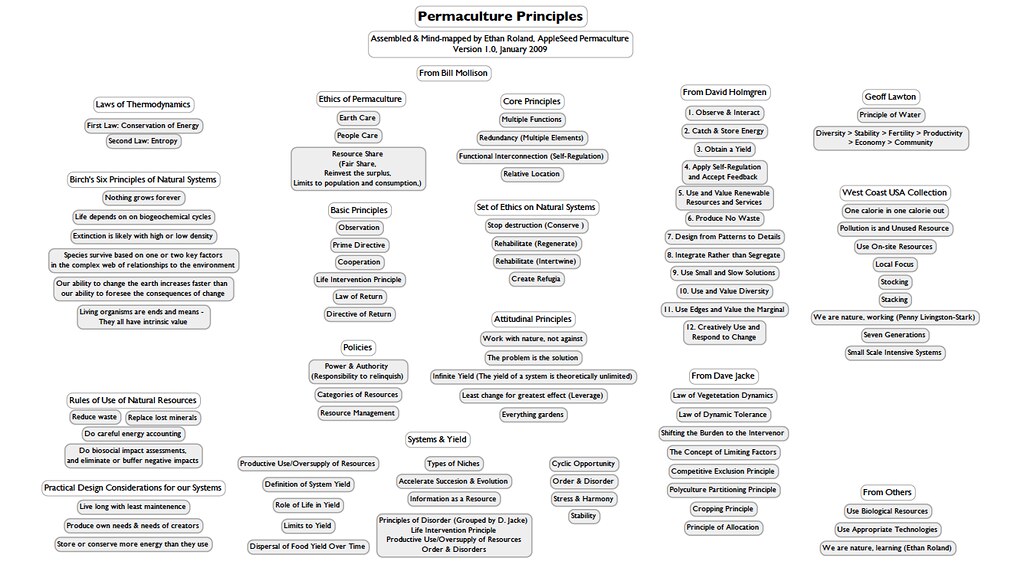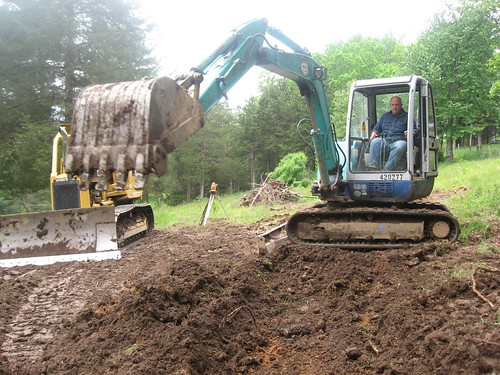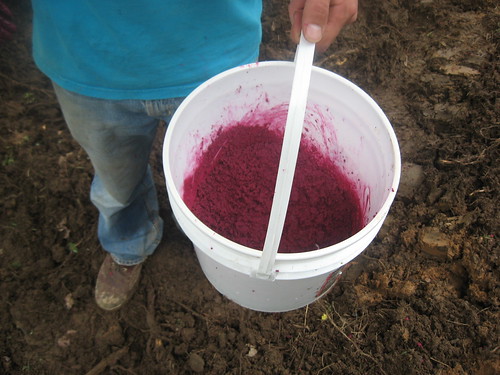This blog replaces my old blog at www.permaculturedesigns.blogspot.com.
For now, cheapest check out the Carbon Farming Course!


This blog replaces my old blog at www.permaculturedesigns.blogspot.com.
For now, cheapest check out the Carbon Farming Course!

Over the past 2 years I’ve been developing an economic design tool for ecological agriculture enterprises.
It creates ten to fifty-year profit and loss projections based on hand-collected & collated hard research data on the following ag enterprise areas:
• Permaculture food forests, forest gardens & agroforestry areas;
• Mixed-fruit orchards;
• Small fruits, berries & hardy kiwi + grape vineyards;
• Organic annual & perennial vegetable production w/ no-till beds & greenhouses;
• Rotational grazing layouts & keyline patterns for larger livestock
• Chickens, ducks, bees and other micro-livestock;
• Composting, worm composting, and aerated compost tea production;
• Short-rotation coppice biomass production for heating & biofuels;
• Gourmet and medicinal mushroom production;
• Wetland agriculture, aquaculture & pond polyculture systems.

Pilot farms using the tool’s projections are being developed in the Hudson River valley, integrated with residential and institutional developments. For an example farm prospectus created with the tool, click here.
Anyone interested in collaborating? Contact me: ethan[at]appleseedpermaculture.com and http://twitter.com/ethanappleseed
Ever notice that there seems to be a plethora of permaculture principles? And that every permaculture teachers tends to use a different set?
How could this have happened? Is this a lack of consensus in the permaculture movement? Is there a definitive set of permaculture principles?
To understand these questions better, I started to collect EVERY PERMACULTURE PRINCIPLE that I’ve ever seen anywhere. I’ve created a first-draft graphic collection of all the principles that I’ve found so far, organized by originator/lineage — take a look below!

You can download a .pdf of this first draft here.
What do you think? Is this useful?
Have you encountered a principle that’s not on this map? Let everyone know in the comments below!
(Thanks to permapower for the post that encouraged me to post this!)
Yesterday, visit this Greg Landua of BooyaCacao and Nemawashi Venture Altruism presented at the Green Ventures Conference. Our slideshow, price which presents ground-breaking work on the new realm of Ecosystem Investing, is posted on slideshare.net and below:
[slideshare id=1475323&doc=fpcecoinvest090521-090522104149-phpapp02]
The summary of ecosystem investing is as follows:

Would you like to invest in any of these businesses? Or have us give this talk elsewhere? Or, do you think this is all crazy? Comment below.

Yeehaw! Working with permaculture water-harvesting principles, we dug a small pond and connected it to more than 400ft of rain-capturing-forest-garden-watering contour swales. I worked with Tristan Vis (a past PDC student of Geoff Lawton‘s and mine) and a local earthmover Dick Stokes for 8 hours yesterday to get everything in the ground, cleaned up, and seeded with a mix of nitrogen-fixing groundcovers.
Dick skillfully operated an 8-ton CAT D4C Bulldozer in concert with a 4-ton excavator to dig the swales and excavate the pond. We calculated the water catchment on top of the ridge to be approximately 19,000 gallons per month (average), and the 400ft of swales (3 ft wide at the base, 4 ft wide at a height of 1.5 ft) have capacity to catch and infiltrate approximately 18,000 gallons into the ground when full.
We seeded the swales with red clover (Trifolium pratense)& Alfalfa/lucerne (Medicago sativa).

Here’s Tristan & I in front of the lower swale.
Interested in permaculture earthworks for your property? Contact me over at www.appleseedpermaculture.com
Young apple tree bark stripped off by rodents! Oh no! What can we do?!? Ethan Roland of AppleSeed Permaculture attempts a bridge-grafting technique (basically a skin-graft!) to heal the tree — connecting the root system back to the living bark further up the tree. This is at Jason Kass’s place in VT during a Permaculture Design Course. For more on bridge-grafting, see here: http://www.bit.ly/mJybO
So what’s the role of architects in all of this?
Architects often become the de-facto landscape designers, because the majority of money in any development budget is spent on the buildings. Any landscapes design, much less integrated landscape design, is a often a tired afterthought. To go beyond sustainability, we need to step past this paradigm! The following notes are from a talk I gave at the University of Massachusetts in September 2008
As architects for a resilient & thriving future, here are your tasks:
• OBSERVE – prolonged at thoughtful observation instead of protracted and thoughtless action
• DESIGN the simplest, most functional, and most vital built ‘environments’ possible.
• INTEGRATE your buildings with the landscape so that they functionally interconnect with as many living systems as possible
• REGENERATE openly seek out and heal the damage and oppression done to living systems — both internally and externally.
• LEVERAGE your work to do the greatest good for the greatest number of beings for the longest amount of time by EMPOWERING people to design with you. Spread your energy and knowledge and excitement through the networks as fast as possible.
Ask yourself:
– What is the simplest solution? what’s the most functional? and what will serve the interests of all life-giving forces on the planet and meet their needs in the most harmonious way?
Whad’ya all think? Do these directives resonate with any of you architects out there?
I get this question all the time:
“What are the computer programs you use every day? What are the most useful for your work as a permaculture designer?”
So, here we go…
EVERY-DAY USE
• Omnioutliner Pro – incredible note-taking and organize-everything software. The program I use most.
• Omnifocus – the omnigroup’s implementation of David Allen’s Getting Things Done (GTD) system. beautifully simple and powerful.
• Microsoft Excel – iWork Numbers would work as well, I just haven’t switched over yet.
• Mozilla Firefox 3.0 – advanced web browsing
• Visual Understanding Environment (VUE) – powerful cross-platform mind-mapping; a little quirky at times but really excellent.
WEB APPLICATIONS
• WordPress – powers my website & blogs
• Doodle – best web app for organizing meetings
• Gmail – rocks. best email ever.
• Google Docs – realtime collaborative editing.
DESIGN & MAP TOOLS
• Vectorworks – $1800 professional Computer-Aided Drafting (CAD) software. Awesome, and a steep learning curve.
• Google Earth – free and versatile. combines beautifully with…
• Google SketchUp – free 3D modeling – quick and easy to use
OTHER PROGRAMS
• Adobe CS – especially acrobat, photoshop & indesign
• Preview (Mac OSX) – quick and functional image & pdf editing
• Quickbooks – bookkeeping & invoicing
• Keynote (Mac OSX) – way, way better than powerpoint. seriously.
• Quicktime Pro – most of my video editing here, final touch-ups with iMovie.
AWESOME. Enjoy geekin’ it out.
“…What percentage of the calories in our diet (NE region) should we be getting from perennial crops? Â How if any way should this influence the thinking of people involved in local planning, farmland protection, and smart growth issues?”
My Response:
Howdy Kevin and All!
I think the ‘should’ is difficult. It depends on who we are talking about, and what their goals are.
If we approach this from the CO2 and climate change angle, and set a goal of reducing CO2 emissions by shifting to perennial agriculture, here’s a proposed research track to answer your questions:
• What are the CO2 emissions resulting from annual ag. in the northeast?
• What are the estimated CO2 emissions (or sequestrations!) from perennial ag? We might look at some small-scale estimations (e.g. Martin Crawford’s forest garden in the UK) and larger estimations (Badgersett Research Center‘s Woody Agriculture in MN, Carbon Farmers of America‘s Holistic Management grazing in VT)
• What might be the CO2 emissions resulting from transition between annual & perennial agriculture?
Personally, I think I can get to 5% of my calorie intake from perennial crops by fall 2010. And, I’m going to aim for 50% of my calories from perennial ‘crops’ (including animals!) in the next 5 years.
How about that? 50% by 2015? Anyone else want to give this a try with me?
Cheers,
Ethan

Could someone post a photo of the whole class? And maybe an image of your certificate?
Go Ninja Turtles!
